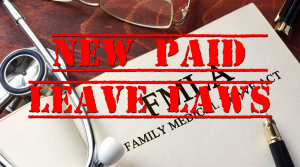 Hours ago the federal government passed the first substantial change to paid leave laws in response to the current public health emergency. Earlier this week, the House passed an amended version of its Families First Coronavirus Response Act, which significantly amends the Family Medical Leave Act and enacts the Emergency Paid Sick Leave Act. On March 18th, the Act was passed by the Senate and was signed into law by the President.
Hours ago the federal government passed the first substantial change to paid leave laws in response to the current public health emergency. Earlier this week, the House passed an amended version of its Families First Coronavirus Response Act, which significantly amends the Family Medical Leave Act and enacts the Emergency Paid Sick Leave Act. On March 18th, the Act was passed by the Senate and was signed into law by the President.
These new laws provide sweeping changes to the already complex maze of paid and unpaid sick leave laws, even as school districts grapple with the unprecedented task of educating students during the COVID-19 pandemic.
Here is what school districts need to know about the new laws before they take effect in the next few weeks.
The Emergency Family Medical Leave Expansion Act
The Emergency Family Medical Leave Expansion Act will go into effect on April 2, 2020, 15 days after the President signed it into law, and will sunset by December 31, 2020. The new law temporarily amends the FMLA in the following key ways.
Coverage. The Act applies to public school districts (regardless of number of employees), as well as all private employers with fewer than 500 employees.
Employee Eligibility. All full and part-time employees are eligible if they have worked for the employer for at least 30 calendar days prior to the designated leave related to the public health emergency. This is substantial change away from the current eligibility requirements of FMLA (1 year of employment, 1,250 hours worked in the 12 months before taking leave).
Leave Entitlement. An eligible employee may take up to 12 weeks of Emergency FMLA, same as the current entitlement under FMLA.
Qualifying Reasons. An eligible employee may take leave under this emergency provision if they are unable to work or telework because of needing to care for the employee’s child (under the age of 18) if the child’s school or place of care is closed or the childcare provider is unavailable due to a public health emergency.
Amount of Paid Leave. The first 2 weeks (10 work days) of the Emergency FMLA leave may be unpaid, but the employee may substitute their accrued but unused paid leave (sick, PTO, vacation, or the new Emergency Paid Sick Leave discussed below).
After 2 weeks, employees get paid at least two-thirds (2/3) of their regular rate of pay for their normal work schedule with a cap of $200 per day and $10,000 per employee in the aggregate. Employees who work part time or whose schedules change week to week must be paid the average number of hours worked over the prior six (6) months.
Intermittent Leave. The Act is unclear whether a district must grant an employee’s request for intermittent leave.
Reinstatement Rights. Employees have the right to return to work to the same or equivalent position, same as the default rules under the current FMLA.
Depending on certain circumstances, the Act potentially allows for limited exceptions for a school district with fewer than 25 employees. In those cases, the district may be permitted to not bring back an employee from Emergency FMLA leave if the employee’s position no longer exists due to the economic conditions related to public health emergency. This exclusion from the job restoration requires the district to make reasonable efforts to return the employee to work for up to one year following the employee’s leave (think of it as an abbreviated version of the reduction-in-force requirement within the Teacher Tenure Act that requires the employer to return an employee up to three years after the involuntary leave).
Discrimination, Retaliation, Liability. The same anti-discrimination and anti-retaliation provisions under the current FMLA apply to the new revisions.
Emergency Paid Sick Leave Act
Similar to the emergency changes to FMLA, the Emergency Paid Sick Leave Act will go into effect on April 2, 2020, 15 days after the President signed it into law, and will sunset by December 31, 2020. The key provisions of the new law are below.
Coverage. The Act applies to all public school districts (regardless of number of employees), as well as all private employers with fewer than 500 employees.
Employee Eligibility. All full and part-time employees, regardless of days of service.
Leave Entitlement. Employees may receive up to 2 weeks of paid sick leave, so 80 hours for full-time employees and a pro-rata amount for part-time employees (equal to the average number of hours worked during a two-week period).
Qualifying Reasons. An employee may take paid sick leave under the Act if they are unable to work or telework because of at least one of the following reasons:
- Governmental (federal/state/local) Order to quarantine or self-isolate;
- Advised by health care provider to self-isolate;
- Symptoms of COVID-19 and seeking medical diagnosis;
- Caring for family member who is subject to a quarantine/isolation order or who has been advised by a health care provider to self-isolate; or
- Caring for child whose school is closed or child care provider is unavailable.
Amount of Paid Leave. School districts must pay an employee taking leave for any of the first three reasons listed above at the employee’s regular rate of pay, capped at $511 per day or $5,110 per employee in the aggregate.
If an employee takes paid sick leave for a family member or child (one of the last two reasons listed above), the employee shall be paid at two-thirds (2/3) of their regular rate of pay, capped at $200 per day or $2,000 per employee in the aggregate.
Other Accrued Leave. Employees can use this Emergency Paid Sick leave first and a school district cannot require the employee to exhaust other paid leave prior to the Emergency Paid Sick leave. In other words, an employee gets paid sick time under the new law in addition to any other accrued paid leave.
Carryover. Paid sick leave under this Act does not carry over to the next year. Also, post-employment payout for this paid sick leave is not available to employees.
Discrimination, Retaliation, Liability. The Act includes anti-discrimination and anti-retaliation provisions, and allows for the same liability and penalties as available under the FLSA.
Federal and state government continue to develop additional responses to the ongoing public health emergency. At Mickes O’Toole, our Education Department will continue to monitor and provide updates as things change. In the meantime, our attorneys are ready to assist the education community with questions regarding COVID-19. Please reach out to us at the number below.
Natalie Hoernschemeyer | Grant Wiens
(314) 878-5600
